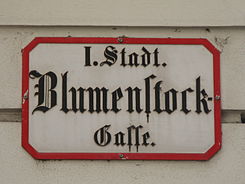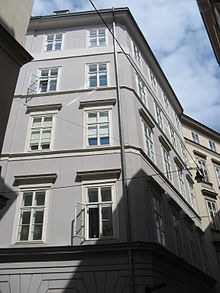Blumenstockgasse
| Blumenstockgasse | |
|---|---|
| Street in Vienna Inner City | |
| Basic data | |
| place | Vienna Inner City |
| District | Inner city |
| Created | no later than the 14th century |
| Hist. Names | Ballgasse |
| Cross streets | Rauhensteingasse, Ballgasse |
| use | |
| User groups | Foot traffic |
| Technical specifications | |
| Street length | about 60 meters |
The Blumenstockgasse located on the 1st Viennese district of Inner City . It was named after the house Zum Blumenstock in 1862 .
history
The Himmelpfort Monastery of St. Agnes has been located in the area of today's Blumenstockgasse 2 since 1267. This monastery had previously interrupted the straight connection between Ballgasse and Rauhensteingasse; Today's Blumenstockgasse formed part of Ballgasse. After the monastery was demolished in 1783, a straight line connection to Rauhensteingasse was created, which initially remained nameless. In 1862 it was made the starting point of Ballgasse, while the previous beginning of Ballgasse was renamed Blumenstockgasse.
Location and characteristics
The Blumenstockgasse stretches from the Rauhensteingasse in an irregular course and kinks to the southeast to the Ballgasse, the beginning of which it was originally. Like Ballgasse, the short lane forms a contiguous pedestrian zone with it , which is frequented by tourists because of its picturesque location and the uniform, classicistic construction. There are also several restaurants here.
building
No. 1 residential building
The classicist house was built by Anton Grünn in 1828 . It is free-standing on three sides between Weihburggasse, Rauhensteingasse and Blumenstockgasse and is at the main address Rauhensteingasse 1.
No. 2 residential building
A part of the former Himmelpfort monastery was originally located here. In 1787 Josef Gerl built the current building for Count Camillo von Colloredo, taking into account the structure of the monastery. The Grand Lodge of the Freemasons in Austria has been located here since 1985 . The house is free-standing between Blumenstockgasse, Rauhensteingasse and Ballgasse and is at the main address Rauhensteingasse 3.
No. 3 residential building
The narrow late classicist house was built by Josef Klee in 1827 . The simpler rear facade is on Blumenstockgasse; the main address is on Weihburggasse 8.
No. 5 To St. Trinity
From 1702 a building was owned by the Himmelpfortkloster, in which Ludwig van Beethoven lived from 1819–1820 . In 1832 Josef Klee built today's corner house on Ballgasse in the late classicist style. The Zum new Blumenstock beer tavern has been located in it since the 1840s .
The facade has a grooved base zone with segmented arches, a round arched portal with fighters and a basket arched portal, as well as a corner curbstone. The upper zone is completely smooth, the windows are arranged additively and sometimes suspect. A cornice runs around the facade. Inside is a barrel vaulted hallway. The original railing can still be seen on the spiral two-pillar staircase. On the ground floor there was the former beer tavern with gilded stucco on the right, while on the left was a blacksmith's workshop, which formed a pillar hall with square vaults and belts .
literature
- Richard Perger: streets, towers and bastions. The road network of the Vienna City in its development and its name . Franz Deuticke, Vienna 1991, ISBN 3-7005-4628-9 , p. 25.
- Felix Czeike (Ed.): Blumenstockgasse. In: Historisches Lexikon Wien . Volume 1, Kremayr & Scheriau, Vienna 1992, ISBN 3-218-00543-4 , p. 406 ( digitized version ).
- Bundesdenkmalamt (Ed.): Dehio Handbuch Wien. I. District - Inner City . Verlag Berger, Horn 2003, ISBN 3-85028-366-6 , p. 650.
Web links
Coordinates: 48 ° 12 ′ 23.8 ″ N , 16 ° 22 ′ 24 ″ E


